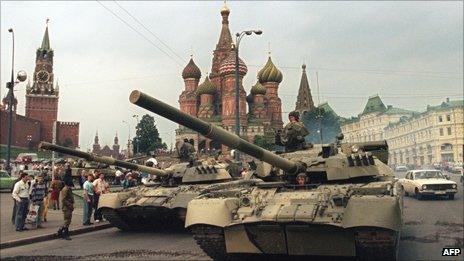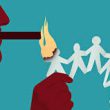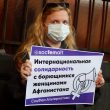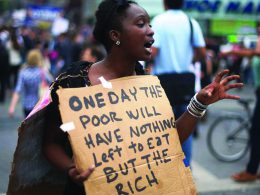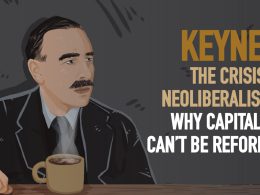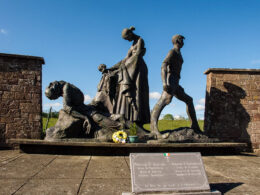August 19, 1991 — an eight-man junta announced that the head of the Soviet Union General Secretary Mikhail Gorbachev had been taken ill, and an “Emergency Committee” had taken over running the vast country. The defeat of the putsch opened the road to the collapse of the USSR writes Rob Jones, an eye-witness to, and participant in the events in MoscowSotsialisticheskaya Alternativa — our sister organisation in Russia
The impression of the press conference on 19 August 1991 as eight aged generals, KGB officers and Stalinist bureaucrats announced ‘emergency rule’ could not have filled those who hoped they would save the Soviet Union with confidence.
Nothing could demonstrate better how the junta was not just out of touch, how little support it really had, than the tanks it sent trundling into Moscow on that sunny Monday morning driven by young conscripts, who sometimes even had “Y-plates” [indicating learner drivers] on their armour, and which stopped when traffic lights turned red! By the time the tanks reached Manezh Square, next to Red Square and the Kremlin, the tank drivers found their path blocked by trolley-buses, disabled by their drivers to act as a temporary blockade.
No one particularly organised the first response. The state media simply broadcast the press conference of the coup-leaders interspersed with the ballet “Swan Lake”. There were no mobile phones, or internet then, landlines were overloaded. People just told friends, family, workmates and started to flood into the city centre. The same happened in what was then Leningrad [now St Petersburg] and other cities across the massive country.
At mid-day, rumours started to circulate in the crowd that had already gathered in Manezh Square and had been fraternising with the tank drivers, who had parked their vehicles in a line alongside the building that housed the huge bureaucracy of the ‘State Plan’ [now housing the Russian State Duma -Parliament]. Boris Yeltsin, who had in June been elected President of the Russian Federation [biggest of the 15 Soviet republics], had called for a General Strike. Unlike Gorbachev, he had not been arrested but had fled with his collaborators to the White House, the building of the Russian Government. From there he called on people to come to defend the White House.

By evening, despite torrential rain, hundreds of thousands of ordinary Moscovites had surrounded the building, staying around the clock, taking turns, until the defeat of the coup. Barricades were built on the entry roads, and barge drivers blocked the River Moskva which flows along the front of the White House to prevent the use of boats.
We quickly learned the real nature of the coup. One of our members at the time, a young steelworker who worked at a plant about 50 km from Moscow hearing the news went into work expecting to call his fellow workers out in protest. As he arrived at the factory he was met at the door by the KGB, who warned him there would be no talk anymore of an independent trade union. “Order’ they said ‘was being restored”. To start with, others kept their heads low. But by evening, they were already forming a squad and trying to find weapons to defend the town. As in Moscow, the declaration by the coup plotters of a curfew and that anyone seen on the streets would be arrested fell on deaf ears.
What motivated the coup leaders?
They are often presented as being opposed to Gorbachev’s policies of ‘Perestroika’ and ‘Glasnost’ and that these policies were leading the USSR down the road to the capitalist market. This is, at least, a crude simplification.
The existence of the planned economy in the USSR had seen the formerly backward Russia, following the October revolution, develop a powerful economy able to defeat the might of Hitler’s regime to become the second economic power in the world. But at the same time, the monstrous Stalinist bureaucracy that developed given the country’s backwardness and as a consequence of failure of the revolution in Europe deprived the planned economy of democracy which, as Trotsky put it, is as vital to communism as oxygen is to the body. Horrific mismanagement in the earlier decades held back economic progress. By the 1980s, the then 20 million strong, parasitic bureaucracy became an absolute fetter to further development.
Mikhail Gorbachev became General Secretary of the Communist Party of the Soviet Union, and thus head of the USSR in 1985. His appointment represented the victory for a wing of the Soviet bureaucracy that realised that change was needed if they were to maintain their grip on power. Revolts had already spread across Eastern Europe and Poland was in the grip of ferment. In the decade before he came to power world oil prices had wavered from $60–130 a barrel. To a certain degree this hid the depth of the growing economic crisis in the Soviet Union, but in 1985 they collapsed to $30 and remained below £60 until the end of the decade. The huge disbalance of Soviet production to support the bloated bureaucracy and their military complex could no longer be hidden under oil money.
Perestroika and glasnost
Gorbachev’s answer was outlined in a speech in 1986 — he called for ‘perestroika’ and ‘glasnost’ — reconstruction and openness. The first was intended to renew and modernise the bureaucratic apparatus. He even allowed for a period for workforces to elect factory managers. The second was meant to shine light on the operations of the bureaucracy. Non-party candidates within limits were even allowed to participate in elections. These moves in the early days were extremely popular.
After an opposition pushing for more radical reforms crystallised in the Supreme Soviet, even though they were still members of the communist party, huge crowds would gather outside shop-fronts to watch the televised sessions of the parliament. A key element was the transfer of many state-owned enterprises to the system of “khozrachet” — in effect self-financing. No longer would factory managers simply rely on state orders as part of the state’s economic plan — instead they were given freedom to decide how to use their finances, and boost them from outside sources. In 1988 a new law allowing for cooperatives to be established was passed. Gorbachev did not intend to restore capitalism, these reforms from above were meant to prevent revolution from below.
These changes led to absolute chaos. The first signs of disaster of course were seen when the Chernobyl nuclear power station exploded in 1986. In 1988 an earthquake shook Soviet Armenia leaving 50,000 dead. The 1989 withdrawal of Soviet troops from Afghanistan was a major humiliation. Again and again, the incompetence of the bureaucracy lead to horrific consequences.
Gorbachev’s attempts to revitalise the economy merely led it into freefall. The relaxation of price controls on agricultural products saw prices skyrocket. The bureaucrats used the relaxation of controls as the excuse to open up a huge campaign of plundering. Crude measures to tackle alcoholism by simply banning its sale led to an explosion of home distilleries and shortages of anything that could be used to make drink. Shops ran out of food. By 1990 there was even rationing of some basic foodstuffs in Moscow and other cities. This chaos coincided with a certain upturn in the western economies — the bureaucrats were more and more drawn to ‘the market’.
By 1990 the Soviet bloc was literally collapsing. In Poland the first non-communist government was elected, the Berlin Wall was torn down and on 25th December 1990 a workers’ uprising threw out the hated Ceauşescu dictatorship, with a firing squad executing him and his wife publicly on television. Yugoslavia was racing towards break-up and horrific ethnic conflicts.
Not only was the Gorbachev regime unable to intervene to stop this process, his policies simply encouraged the growth of discontent across the USSR. Demonstrations were put down by force in Kazakhstan, mass protests about the state of the environment hit the Caucasus and Baltic states. Ethnic conflict broke out in Nagorno Karabakh and elsewhere. Mass movements for self-determination spread across the Baltic states, Moldova and elsewhere.
But events were also developing out of control within the largest of the Soviet republics, Russia itself. Widespread shortages of life’s necessities caused massive discontent within the working class. When there was no soap in the pit-head showers, the mighty miners’ movement developed.

The first strikes in 1989 in Vorkuta, in Russia’s far north, took place in support of 6 simple demands:
- pay non-paid wages;
- agree a proper wage and overtime rate for digging coal;
- review production targets as they are too high;
- sort out wage differentials between faces;
- reduce the mine’s administrative apparatus by 40%;
- because of no confidence in the Director of the pit his re-election.
After the demands were posted in the pit, someone scrawled beneath “and liquidate the whole management of “Vorkuta Coal” by 100%.
These strikes spread like wildfire across the Soviet Union. The demands quickly radicalized — not in the direction of the market but echoing Trotsky’s programme of political revolution against the bureaucracy, even if at that time it was not exactly formulated. In August 1989, the head of the Vorkuta City strike committee explained their position:
“We now have just one problem. We want the working class recognized as being in charge in its own ‘workers’ country’. We want to restore confidence in the communist party. The soviets, our trade union. We want to get rid of the bureaucracy that is holding back perestroika. We are for the removal of Article 6 of the Constitution of the USSR [which stated that there was only one ruling party — the Communist Party]. Yes, the party has started perestroika, opened the door to glasnost. But now there are still millions of workers who are far from the leadership. There is still the need for social justice. We hope that the role of the party will change, from one in which it mainly manages the economy into one which at last looks after people”.
The economic demands that were pushed by the miners usually went no further than demanding that Gorbachev’s policy of “Khozrachet” be implemented effectively. The more openly pro-market demands that were later included had been introduced by the new oppositionists, most of whom had come out from the Communist Party itself. Often such demands were added in by the official party structures. But in the absence of an organized workers’ political alternative, the ideas of the growing opposition to Gorbachev within the Soviet State centred around Boris Yeltsin began to dominate the miners’ movement.
Pro-market coup leaders
In this context the economic programme of the coup leaders was clearly not directed at stopping the accelerating drift towards the market. In their statements, there was not a word about Lenin, or of saving socialism or communism, let alone the rights of workers. There were a few populist statements about ending price rises, stopping economic chaos and of plans to send brigades of students and workers to the countryside to harvest the crops. This was to be done under the leadership of the army.
Instead of even returning to the Soviet ‘status quo’, the coup leaders complained about the “chaotic, spontaneous sliding towards the market which is causing an explosion of egoism”. They called for “concrete measures to end the ill-discipline and thieving from the people’s economy” to establish a “strict regime for improving the organization, introducing order and discipline in all parts of society”. This was to be done, in their words, because it was necessary to establish a “mixed economy” and to “support private enterprise, and give it all possibilities to develop production in the service sphere”. This was to be backed up by giving each city resident a plot of land (15 hectares each, which if implemented would have broken up the state and collective farms) and to cancel any restrictions on the free movement of goods, raw materials and equipment within the USSR.
The future fate of the coup plotters indicates what they really wanted. Although arrested and tried for treason, most were out of prison within two years — a stark contrast to the long sentences meted out to today’s protesters in Russia!
Although one, former Minister of Internal Affairs Boris Hugo committed suicide on the third day, others included former Premier Valentin Pavlov, who then built a fortune working in the private banking sector. Oleg Baklanov became President of the Board of Directors of a rocket building company. Vasily Starodubstev was a regional governor and head of the Union of Agro-industrial enterprises. Alexandr Tizyakov became owner and Director of several industrial companies and even an investment fund. Anatoly Lukyanov, who had been Chair of the Supreme Soviet, after the coup became a co-founder of Zyuganov’s communist party and then a board member of an oil and gas exploration company. Valentin Varennikov stayed as a member of the communist party before co-founding the national-chauvinist party “Rodina”.
In defence of the bureaucratic state
The real reason that drove the putschists to organise their military coup was not to maintain even the bureaucratically mismanaged planned economy but to maintain a strong centralised state apparatus during the transition to the market. This was demonstrated by their open opposition to the “New Union Treaty” negotiated by Gorbachev which would have dramatically reduced the powers of the central Soviet state. Six of the former Soviet republics — three Baltic states, Moldova, Georgia and Armenia had already declared their desire for independence from the Soviet Union in 1990.

The remaining republics reached an agreement to significantly change their relationship with the centre. It would have meant that there would be a common President, foreign policy and military. Almost all other functions, including natural resources would be under the control of the republics. The proposal was put to a referendum in March 1991, when 76% voted in favour and was due to be finally signed off on August 20th. The coup cut across that and changed the whole dynamic leading to the complete break-up of the Soviet Union.
There is no doubt that the members of the junta were prepared to use any methods to seize power. A curfew was announced in Moscow. For three days rumours abounded about who was where what troops were moving on the city and so on. Two tank divisions and thousands of troops were mobilised on the first day to take the city. On Tuesday the coup members prepared “Operation Grom” [Thunder] — more tanks, paratroopers and helicopters, as well as the notorious Alpha and Vympel special operations troops, together with the Moscow riot police were to be used to seize the White House. Leading officers, including General Lebed who was later to enter Russian politics as a Pinochet type figure, infiltrated the crowds around the White House to assess the situation before deciding to go ahead. They gave the green light.
But the coup was already falling apart. Even during the initial press conference, Soviet Vice-President Gennady Yanayev’s hands were shaking so badly it was thought he was inebriated. On the second day, they had to dispatch another member, Valentin Pavlov and his wife out of Moscow because they were too drunk. The Alpha special troops had somehow failed to arrest Yeltsin as ordered whilst some of the tank crews who had entered Moscow quickly went over to defend the White House. At one o’clock in the morning as the coup entered its third day a scuffle took place as protesters tried to stop a tank moving towards the White House which left 3 protesters dead. After this, even the elite Alpha and Vympel troops refused to advance as ordered. The coup leaders had to withdraw the troops from Moscow.
Yeltsin’s role
It has entered the mythology about the coup, that Russian President Boris Yeltsin had acted decisively from the start to oppose the coup. Later that day he was pictured speaking to the crowds outside the White House standing on a tank from the Tamanskaya Division, whose commanding officer had pledged to defend the White House. The truth is that Yeltsin’s initial response was to retreat to his dacha outside Moscow where he hoped to form a rival government. He had to be persuaded to return to Moscow. The Communist Party of which both Gorbachev and Yeltsin were leading members at that time sent telegrams across Russia instructing regional and city governments to support the coup. Most did — including key Russian republics such as Tatarstan and Chechnya-Ingushetia, as well as most major city governments. Leningrad was the exception, where the city leadership came out firmly against the coup.
The reality is that there was a popular uprising against the coup. It started almost unconsciously as people simply turned out into the city centres. The disabling of the trolleybuses by their drivers and actions of the barge pilots in Moscow, backed by printworkers at the Isvestia [then one of the two main newspapers in Russia] who threatened to strike if the appeals issued by Yeltsin were not published played a key role. Even on the main TV channels, which had been placed under military control, the decision by the operators to film Yanayev’s shaking hands helped undermine the coup’s authority.

In Leningrad workers at the giant Kirov factory came out of strike. There were so many protesters on the streets there, the military didn’t even try to occupy the city. As news reached the mining areas, strikes began to spread there too. The initial brave initiatives taken in some cases by just a few gave courage and inspired others to join in. Those who had been cautious in the first hours, soon lost their fear.
Already by mid-day on the Wednesday Moscow was fall of rumours. Were the tanks moving in or pulling out? What had happened to Gorbachev? Had the coup leaders been arrested? Then the buzz went around that the coup had collapsed. Gorbachev flew back to Moscow arriving in the early hours of Thursday morning as the remaining coup plotters were arrested. But both Gorbachev and the Soviet Union were fatally damaged. Yeltsin as Russian President took over control and on 25th December the Soviet Union itself was dissolved.
This opened the road to the rapid restoration of capitalism across the fifteen new countries. The following decade was a disaster for most who lived in these countries. The ruling bureaucracy transformed itself into a new capitalist class, using forced privatisation, gangsterism, the plundering of state property, ethnic conflict. The economy suffered an incredible collapse — with GDP falls of over 50% and inflation at one stage reaching nearly 3000%. Many regions have not restored former levels even now. Workers were often expected to work without pay for months on end.

In some regions, while people lived in flats, they prepared meals outside on fires to save money. Ethnic conflict and war swept the region — the five-year civil war in Tajikistan which took tens of thousands of lives and left a million refugees, two wars in Chechnya (1994–6 and 1999–2000) which left hundreds of thousands dead as well as conflicts in Moldova, Georgia, Ukraine, Armenia and Azerbaijan, all with the involvement of Russia. Only for a period between 2000 and 2008 was there a period of relative growth and stability.

When the Soviet miners organised, their main grievances were against the bureaucracy and its mismanagement. Even when they raised demands on the economy, they were aimed at improving the economy, not restoring capitalism. The pro-market demands came from the bureaucracy itself, and a large part of the intelligentsia. But even they were not able to openly call for capitalist restoration, their economic demands were smuggled into mass consciousness under the guise of “democracy”. The call most frequently heard, including from the miners was for the abolition of Article 6 of the Constitution.
But the new capitalism was far from democratic. It introduced multi-party elections and for a period there were elements of bourgeois democracy, with the freedom of parties, a relatively free press and a retreat of the repressive regime. But this ‘democracy’ was far from stable and didn’t last the decade.
In 1993, Yeltsin’s former allies in the fight against the putsch, Aleksandr Rutskoy and Ruslan Khasbulatov, led Russia’s parliament the ‘Supreme Soviet’, in which the majority was held by “Russian Unity”, which included communists, militarists and the right-wing nationalists. They claimed to be concerned about the consequences of the Yeltsin government’s rapid transition to the market, which Rutskoy described as ‘economic genocide’, although they were probably just as much concerned with the fact that they were not profiting from the process as much as others. The Parliament tried to reduce Yeltsin’s powers as President. The struggle culminated in September 1993 with the order issued by Yeltsin to suspend and lay siege to the Supreme Soviet in the White House.

This time, demonstrations to defend the White House consisted of a strange mixture of genuine, but disgruntled workers dominated by reactionary forces, including unofficially, units of former riot police and the fascist ‘Russian National Unity’. Russia’s so-called ‘communists’ saw absolutely no contradiction about their alliance with fascists! After a clash between police and those around the White House ran out of control, the protesters stormed the television premises. That night Yeltsin sent tanks to bomb the White House, by the end of the week hundreds had been killed (officially the regime accepts 147 died).
Democracy discredited
Memories of this period, which many workers started to refer to as not ‘demokratiya’ but ‘dermokratiya’ [shitocracy], helped to undermine amongst a whole generation the need to fight authoritarianism. The restoration of ‘democracy’ was associated with mass poverty, ethnic conflict and the struggle between different sections of the ruling elite to take over the wealth and resources of the former Soviet Union. The Yeltsin epoch which lasted till 1999 was marked by chaos and collapse. It was enshrined in the image of the President himself as a drunken, stumbling fool. But it was a necessary stage in the restoration of capitalism, as it saw the complete break-up of the remnants of the old Soviet state. Putin, who was nominated by Yeltsin himself to take over has changed direction, to rebuild a new strong, authoritarian state to serve the interests of the new capitalism.
Now, twenty-two years into Putin’s regime, a new generation of young workers has grown, and is growing up unfettered by the baggage of the past and determined to fight authoritarian rule and capitalism. They will not allow a new socialist Russia to be merely a copy of the former bureaucratised and authoritarian USSR. Instead, it will be based on genuine democracy with the freedom to organise, speak and chose personal lifestyles, on the public ownership of the wealth and resources, with the right of self-determination for all nations all under the control of democratically elected bodies representing the wider working class to ensure that society is run in the interests of all.





